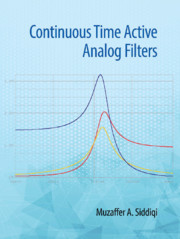Book contents
- Frontmatter
- Dedication
- Contents
- Preface
- Acknowledgments
- 1 Analog Filter: Concepts
- 2 First-and Second-order Filters
- 3 Magnitude Approximations
- 4 Delay: Approximation and Optimization
- 5 Frequency and Impedance Transformations
- 6 Sensitivity of Active Networks
- 7 Single Amplifier Second-order Filters
- 8 Multi Amplifier Second-order Filter Sections
- 9 Direct Form Synthesis: Element Substitution and Operational Simulation
- 10 Cascade Approach: Optimization and Tuning
- 11 Amplification and Filtering in Biomedical Applications
- 12 Audio Signal Processing and Anti-aliasing Filters
- 13 Follow the Leader Feedback Filters
- 14 Switched Capacitor Circuits
- 15 Operational Transconductance Amplifier-C Filters
- 16 Current Conveyors and CDTA (Current Differencing Transconductance Amplifiers) Based Filters
- 17 Active R and Active C Filters
- Index
- References
17 - Active R and Active C Filters
Published online by Cambridge University Press: 24 December 2019
- Frontmatter
- Dedication
- Contents
- Preface
- Acknowledgments
- 1 Analog Filter: Concepts
- 2 First-and Second-order Filters
- 3 Magnitude Approximations
- 4 Delay: Approximation and Optimization
- 5 Frequency and Impedance Transformations
- 6 Sensitivity of Active Networks
- 7 Single Amplifier Second-order Filters
- 8 Multi Amplifier Second-order Filter Sections
- 9 Direct Form Synthesis: Element Substitution and Operational Simulation
- 10 Cascade Approach: Optimization and Tuning
- 11 Amplification and Filtering in Biomedical Applications
- 12 Audio Signal Processing and Anti-aliasing Filters
- 13 Follow the Leader Feedback Filters
- 14 Switched Capacitor Circuits
- 15 Operational Transconductance Amplifier-C Filters
- 16 Current Conveyors and CDTA (Current Differencing Transconductance Amplifiers) Based Filters
- 17 Active R and Active C Filters
- Index
- References
Summary
Introduction
Conventionally, the design of OA-RC (operational amplifiers with resistors and capacitors) circuits assumes that OAs are ideal, having a large frequency independent gain. However, a commercially integrated OA is a non-ideal device, whose gain is frequency dependent and exhibits a LP (low pass) characteristic. A simple model for OAs, given in Chapter 1, is repeated here depicting its frequency dependent gain nature.
In equation (17.1), ωa is its first pole, Ao is the gain at dc and B = Aowa is gain bandwidth product. This effect of the gain bandwidth product, B, being finite, its effect on the magnitude and phase responses of the filter became important criterion for comparison of the performance of filters. Finite B restricts the frequency range of the operation of OA-RC filters to mostly the audio frequency range, particularly when commercially economical OAs, such as OA 741, are used. In fact, in some topologies, product of pole-Q and center frequency wo has to be much less than B to avoid undesirable enhancement in Q, and likely instability. Consequently, suitable compensating schemes were developed to design filters with lesser dependence on OA gain characteristics, like those shown for integrators in Chapter 2; in other cases, specially designed but costly OAs were used.
In an alternative approach, instead of considering the frequency dependent gain of the OA as undesirable, it has been exploited by using it directly in the design itself. This approach increases the frequency range of operation, and also reduces or completely eliminates the requirement of external capacitors. In this context, networks which use only OAs and resistors, with no external capacitors in their implementation, and derive their response from the internal dynamics of the OAs, are known as active R circuits [17.1], [17.2].
Similar to active R, active C networks have also been designed. They utilize the frequency dependent model of the OAs, but use only capacitances, mostly in ratio form. It results in an extended frequency range; the use of small value capacitors in ratio form provides related advantages.
Basic Techniques in Active R Synthesis
Active R synthesis is an off-shoot of the active RC synthesis, where external capacitors were eliminated. Hence, the techniques used in the active RC synthesis are only tailored to suit active R realizations; these are briefly discussed in this section.
- Type
- Chapter
- Information
- Continuous Time Active Analog Filters , pp. 538 - 592Publisher: Cambridge University PressPrint publication year: 2020



